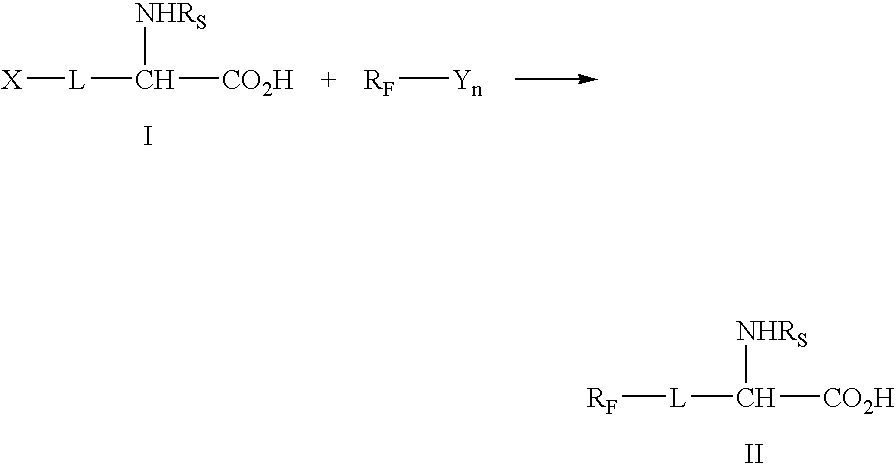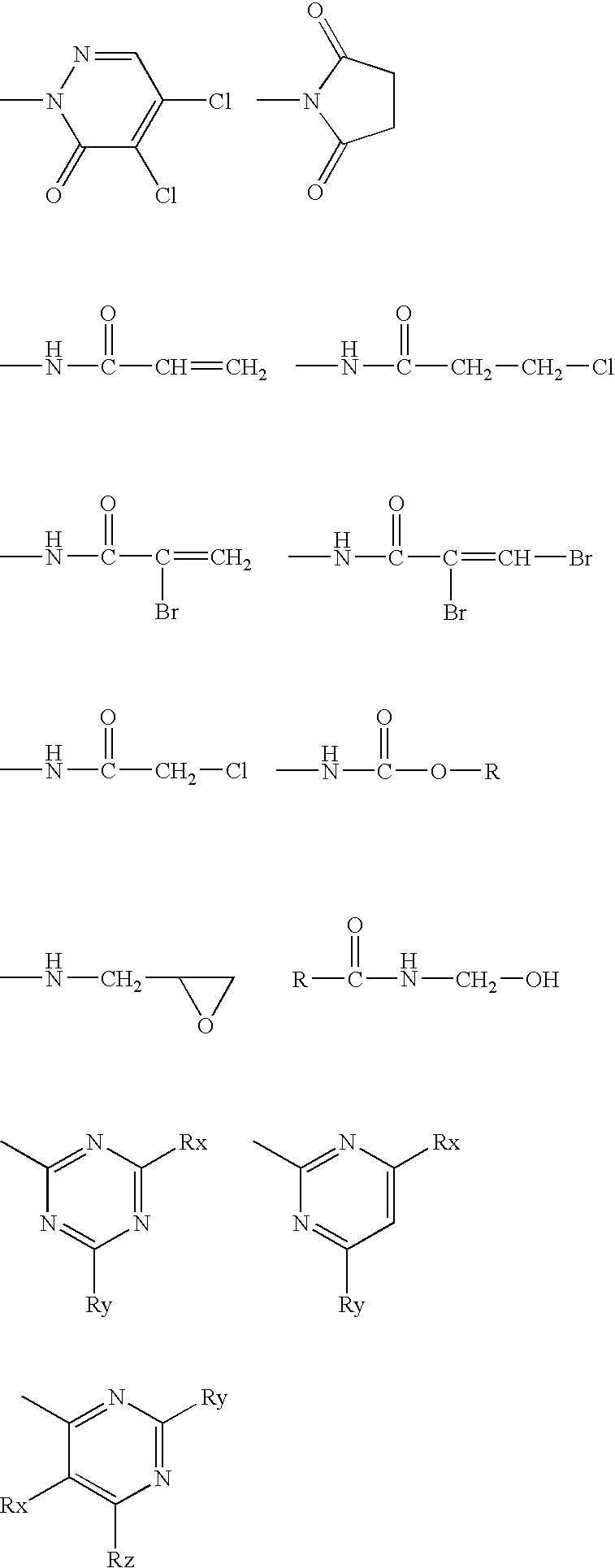Highly affine cosmetic agent
a cosmetic agent and high affinity technology, applied in the field of cosmetic agents, can solve the problems of difficult to avoid sites, awkward handling of methods, and material not suitable for cosmetic use, and achieve the effect of high variability
- Summary
- Abstract
- Description
- Claims
- Application Information
AI Technical Summary
Benefits of technology
Problems solved by technology
Method used
Image
Examples
example 1
Preparation of 5-((4-((5-amino-5-carboxypentyl)amino)-6-hydroxy-1,3,5-triazin-2-yl)amino)-4-hydroxy-3-(phenylazo)-2,7-naphthalenedisulfonic acid disodium salt (formula III)
Step 1
[0192]6.15 g (10 mmol) of Reactive Red 2 (based on 100% pure dye) and 2.0 g (11 mmol) of D,L-lysine hydrochloride were dissolved in 30 mL of water, and the pH was adjusted to 9-9.5 with 30% sodium hydroxide. The solution was then heated to 40° C. and stirred 6 hours while keeping the pH and temperature constant. The mixture was cooled to room temperature, and 5-((4-((5-amino-5-carboxypentyl)amino)-6-chloro-1,3,5-triazin-2-yl)amino)-4-hydroxy-3-(phenylazo)-2,7-naphthalenedisulfonic acid disodium salt was made to precipitate by addition of methanol in an amount commensurate with the crystallization.
Step 2
[0193]The moist product from Step 1 was taken up in 20 mL of water, 20 mL of 30% sodium hydroxide solution was added, and the reaction mixture was heated to 90° C. After 6 hours, the mixture was cooled, carefu...
example 2
Preparation of 1-amino-4-((3-((2-(((5S)-5-amino-5-carboxypentyl)amino)ethyl)sulfonyl) -phenyl)amino-9,10-dioxo-9,10-dihydro-2-anthracenesulfonic acid sodium salt (formula V)
Step 1
[0195]6.26 g (10 mmol) of Reactive Blue 19 (based on 100% pure dye) and 2.7 g (11 mmol) of N(alpha)-BOC-L-lysine were dissolved in 30 mL of water, and the pH was adjusted to 9-9.5 with 30% sodium hydroxide. The solution was then heated at 90° C. for 6 hours while keeping the pH constant at 4.5 by addition of sodium hydroxide solution. The reaction product was then made to precipitate by addition of methanol (about 40 mL). Filtering and drying gave 5.4 g (71% of the theoretical) of 1-amino-4-((3-((2-(((5S)-5-(((1,1-dimethoxyethoxy)carbonyl)amino)-5-carboxypentyl)amino)ethyl)sulfonyl)phenyl)-amino-9,10-dioxo-9,10-dihydro-2-anthracenesulfonic acid sodium salt as a blue powder.
[0196]
Step 2
[0197]2.0 g (2.6 mmol) of the compound from Step 1 was stirred in 10 mL of hydrochloric acid (concentration: 1 mol / L) for 2 ...
example 3
Preparation of (2S)-2-amino-6-((2,4-dinitrophenyl)amino)hexanoic acid (N-6-(2,4-dinitrophenyl)-L-lysine)
Step 1
[0199]1.86 g (10 mmol) of 2,4-dinitrofluorobenzene and 2.7 g (10 mmol) of N(alpha)-BOC-L-lysine were heated in 30 mL of acetonitrile at 90° C. for 6 hours. The batch was cooled to room temperature, and the acetonitrile was distilled off. This gave 4.1 g (99% of the theoretical) of 6-((4-amino-2-nitrophenyl)amino-(2S)-2-(((1,1-dimethylmethoxy)carbonyl)amino)hexanoic acid (formula VI) as a bright yellow solid residue.
[0200]
Step 2
[0201]3.2 g (7.8 mmol) of the compound from Step 1 was stirred in 10 mL of hydrochloric acid in dioxane (concentration: 3 mol / L) at room temperature for 3 hours. At the end of the reaction, the dye was made to precipitate by addition of 20 mL of diethyl ether. Filtering and drying gave 2.1 g (95% of the theoretical) of (2S)-2-amino-6-((2,4-dinitrophenyl)amino)hexanoic acid (N-6-(2,4-dinitrophenyl)-L-lysine) (formula VII) as a bright-yellow powder.
[0202...
PUM
| Property | Measurement | Unit |
|---|---|---|
| Composition | aaaaa | aaaaa |
| Strength | aaaaa | aaaaa |
| Softening point | aaaaa | aaaaa |
Abstract
Description
Claims
Application Information
 Login to View More
Login to View More - R&D
- Intellectual Property
- Life Sciences
- Materials
- Tech Scout
- Unparalleled Data Quality
- Higher Quality Content
- 60% Fewer Hallucinations
Browse by: Latest US Patents, China's latest patents, Technical Efficacy Thesaurus, Application Domain, Technology Topic, Popular Technical Reports.
© 2025 PatSnap. All rights reserved.Legal|Privacy policy|Modern Slavery Act Transparency Statement|Sitemap|About US| Contact US: help@patsnap.com



